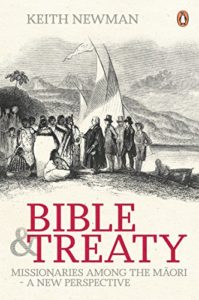Bible & Treaty: Missionaries among the Māori—A New Perspective, Keith Newman, Penguin Books, 2010, 367 pages. ISBN: 9780143204084. Available on Amazon.
When I read Bible & Treaty, not long after it was first published, I could not put it down. Roughly covering the period of 1800–1864, it tells the story of how the gospel first came to the Māori people of Aotearoa New Zealand. Bible & Treaty is a book that can help all who have made New Zealand home, including the Chinese, be far more aware of this nation’s rich Christian heritage. Interestingly, it is a story that also resonates with the story of mission in China and elsewhere.
Newman describes in detail the events leading up to and following the historic Christmas Day sermon in 1814 given by CMS (Church Missionary Society) Anglican missionary Samuel Marsden to some 400 Māori who were also joined by several missionaries and other Europeans. Marsden’s friend, young Māori chief Ruatara, also spoke to the gathered crowd explaining in the Māori language what Marsden had preached in his sermon from Luke 2, “I bring you good tidings of great joy.” This first preaching of the gospel in New Zealand took place in the Bay of Islands in the north of the North Island and was where early missionaries focused their efforts.
Newman goes on to describe how, after a slow beginning, the gospel began to bring transformation as it spread among the Māori tribes in both the North and South Islands, spread largely because of the Māori themselves sharing the “good news.” As Newman points out, “The stories of the missionaries among the Māori cannot easily be isolated from those of the Māori among the missionaries. The European messengers of the rongopai or “good news” were often profoundly changed by living among the Māori in what was for them a lifelong commitment to service” (p. 7).
Newman not only tells the stories of the early missionaries, but he also looks at “the many previously unknown Māori missionaries whose rich contribution to the moral and cultural transformation of their own people began while the European teachers were still landlocked at the Bay of Islands mission base” (p. 8).
It is many of these stories that, for me, made the book so thrilling. Just one example is the story of Tarore, a young Māori girl brutally murdered in a night-time raid by a “war party” from a rival tribe from Rotorua. Tarore’s father, Waikato chief Wiremu Ngakuku, had become a Christian and even in his grief spoke of forgiveness and of his desire for there to be peace, not war, between the tribes. He refused to follow the path of “utu” or revenge. The story does not end there. Amazingly, during the raid, Uita, the one who killed Tarore, had snatched the copy of Luke’s gospel that Tarore had with her—a precious book that had been translated and printed by missionaries in the Bay of Islands. Later when Uita, who was illiterate, heard the book read to him, he was so deeply moved that he knew he had to find Ngakuku and seek forgiveness.
Newman tells the stories of many Māori evangelists, including some who were martyred for the faith. He also writes about numerous missionaries, both CMS and Wesleyan. One particularly remarkable man was CMS missionary Octavius Hadfield who spent a lifetime serving the Māori people. He later became the Anglican archbishop in Wellington.
In Bible & Treaty, Newman outlines the vital role played by the early missionaries in the preparation and signing of the Treaty of Waitangi. The Treaty, which is regarded as the founding document of New Zealand, was first signed on February 6, 1840 by Captain William Hobson representing the British Crown and by Māori chiefs from the North Island. Later, as the document was taken around the country, it was signed by a further 500. In total, the names, or official marks (moko), of 579 chiefs appear on the Treaty.
The Treaty of Waitangi was a sincere attempt to lay down the principles that should govern relationships between the Māori people on the one hand and the British Crown and growing numbers of colonialists on the other. The Treaty recognized Māori ownership of their lands, forests, and other possessions, and gave Māori the rights of British subjects.
Another fascinating part of the story that Newman highlights is the influence on this critical and formative period of New Zealand’s history of the so-called Clapham Sect in Britain. Under the subheading “Humanitarian revolution” Newman gives an excellent account of the influence of this remarkable “group of ordinary churchgoers, ministers, influential and philanthropic businesspeople and politicians, who began to meet regularly in Clapham township, south of London” (p. 22).
In the late 1700s and early 1800s, this group—that included people such as Cambridge evangelical pastor Charles Simeon, philanthropist Lord Glenelg, economist Henry Thornton, and member of Parliament, William Wilberforce—was at the forefront of many important social reforms, including the fight to abolish the slave trade. Wilberforce was a close friend of Prime Minister William Pitt. John Newton, the former slave-ship captain, and composer of the hymn “Amazing Grace,” was Wilberforce’s mentor.
The Clapham Sect “members, were determined that the British would improve the treatment of indigenous people, and they seized on the opportunity to expand mission work throughout the Colonies” (p. 25). Members of the group were closely involved in the formation in 1795 of the London Missionary Society (LMS) and later, in 1799, of the Church Missionary Society (CMS).
It was the next generation, in some cases the children of Clapham Sect members, that carried the torch of reform. James Stephen followed in his father’s footsteps and in the footsteps of William Wilberforce. Newman records that Stephen “was appointed Permanent Under-secretary for the Colonies in 1836 and decreed indigenous people were to be protected and the principle of racial equality maintained” (p. 141). Secretary for the colonies, Lord Glenelg, another son of a Clapham reformer, worked closely with James Stephen. Both were disturbed by reports of the plight of the Māori at the hands of unscrupulous land-grabbing colonial settlers “avid for quick profits” who were exploiting the Māori. The New Zealand Company which was acting on behalf of large numbers of settlers and would-be settlers was becoming more aggressive, and some Māori leaders had petitioned the British for protection.
The Treaty of Waitangi grew out of the desire of the British to ensure the fair treatment of the Māori. The reports sent by the missionaries (in New Zealand), and the values long promoted by influential evangelicals (in Britain) all played a role in shaping the policy of the British government of the time.
What is more, as Newman points out, if missionary Henry Williams had not worked closely with the Māori chiefs and explained to them that the British Crown was wanting to honor their request for protection, the chiefs would never have signed the Treaty. Newman writes, “This was the first time the British had accorded any indigenous race a document promising their protection and granting them British citizenship” (p. 159).
The British governor at the time, Hobson, later declared that if it had not been for the help of missionaries like Henry Williams, “a British colony would not have been established in New Zealand” (p.159).
Despite the positive influence of the missionaries, Newman does not gloss over the unsavory side of this early history—far from it. Some missionaries made huge mistakes and found themselves compromised both morally and politically. People like William Colenso (the printer turned missionary) and high church Anglican Bishop Augustus Selwyn did not exactly endear themselves to the Māori people. While some missionaries clearly failed to live up to their calling, the majority, however, sacrificially served those to whom they were called and saw transformation in lives and communities.
The story of modern New Zealand cannot be divorced from what happened in the past. This is one reason why accurately recording history is so important. Too often history is conveniently forgotten, distorted, or used for political purposes.
In his preface, Newman says, “The role of missionaries in New Zealand’s short history has too often been ignored, minimized or demonized by revisionist historians, who have blamed them for much and credited them with little, even dismissing their peace-making efforts and contributions to literacy” (p. 7). He also points out that some historians dealing with this period of New Zealand’s history have “muddied the water with their post-Christian, postmodernist perspectives” (p. 8).
In Bible & Treaty, Newman focuses on the period up to 1864, after which time, sadly, “the land wars and religious and political power plays” caused great disillusionment and conflict. Newman deals with this turbulent period in his 2013 follow-up book, Beyond Betrayal: Trouble in the Promised Land—Restoring the Mission to Māori.
Today New Zealand is no longer simply a land struggling to balance the interests of two cultures (biculturalism), the Māori and the Pākehā (i.e., non-Māori, European) cultures. The New Zealand of today is increasingly “multicultural,” and a significant number of more recent immigrants are from Asia, including Chinese immigrants.
In a sense, the Māori today still see all immigrants (not just European ones) as Pākehā (“outsiders,” a bit like the Chinese wai guo ren). All non-Māori are also referred to as tangata tiriti or peoples of the Treaty. In other words, the Treaty gives immigrants, including those from Asia, a rightful place in this nation. As Māori Anglican Bishop, Te Kitohi Wirema Pikaahu, referring to the Treaty of Waitangi, put it in an interview on Waitangi Day, February 6, 2022: “The Treaty is the foundation for all peoples—all those who were here at the beginning [in 1840] and also those who have come since.”1
Or as missionary Henry Williams put it back in 1840: “The Treaty has the potential to bring Māori and Pākehā together as one people to build a great nation.”2
Bible & Treaty is not just a meticulously researched and beautifully written account of early Christian witness in Aotearoa New Zealand, it also inspires the reader with many amazing, God-shaped stories that feature in the history of our beautiful land. Keith Newman’s brilliant book is informative, challenging, and inspirational. There is much here to help all New Zealanders, including more recent immigrants (like the Chinese), understand how to better integrate into New Zealand society.
Endnotes
- Online interview with Bishop Te Kitohi (Kito) Wiremu Pikaahu ONZM, Gracecity Church, Auckland. See: https://www.gracecity.nz/waitangi.
- Quoted in Huia Come Home, by Jay Ruka, 2017.
Image credit: Aga Putra @agaputrantara via UnSplash

Peter Anderson
Peter S. Anderson, a former International Director of Jian Hua Foundation (JHF) has been in Chinese ministry for over 45 years. Peter and his late wife Geralyn served with OMF in Taiwan (1976–82) followed by service in Hong Kong and mainland China (1982–2005) with Friends of China and JHF. From 2006–2016 …View Full Bio
